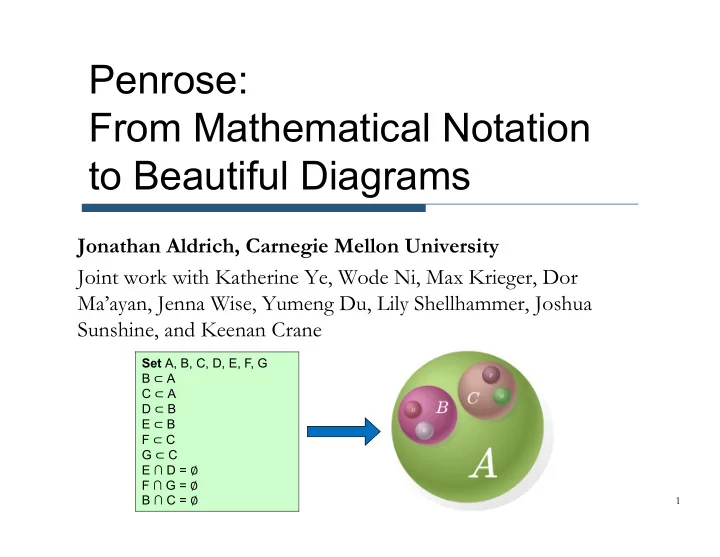

Penrose: From Mathematical Notation to Beautiful Diagrams Jonathan Aldrich, Carnegie Mellon University Joint work with Katherine Ye, Wode Ni, Max Krieger, Dor Ma’ayan, Jenna Wise, Yumeng Du, Lily Shellhammer, Joshua Sunshine, and Keenan Crane Set A, B, C, D, E, F, G B ⊂ A C ⊂ A D ⊂ B E ⊂ B F ⊂ C G ⊂ C E ∩ D = ∅ F ∩ G = ∅ B ∩ C = ∅ 1
Diagrams are useful, but too rare • Diagrams are useful… • Diagrams help in solving math problems [Larkin&Simon] • High-impact papers have many figures [Lee et al.] • But rare: just 39% of arXiv math papers contain diagrams • And even those contain only 1 figure for every 10 pages “People have very powerful facilities for taking in information visually... On the other hand, they do not have a good built-in facility for turning an internal spatial understanding back into a two- dimensional image. [So] mathematicians usually have fewer and poorer figures in their papers and books than in their heads.” - Fields medalist William Thurston 2
The Penrose Vision Penrose generates this: You write this: Or, if you prefer, this: 3
Penrose in Action • Linear algebra – simple intro • Linear algebra – sugar and direct manipulation • SIGGRAPH teaser video 4
Can we create a LaTeX for Diagrams? LaTeX Penrose • Describe document content • Describe mathematical content (.tex) separate from layout (Substance) separate from visual representation • Extensible formatting styles • Extensible rendering (Style) (.sty) • Extensible with new document • Extensible with new math structuring concepts (macros) domains (Domain) • Optimizes (mostly textual) • Optimizes (graphical) layout of layout of documents diagrams 5
Existing tools are inadequate • Graphing calculators (e.g. Wolfram Alpha) • Visualize concrete data or functions • Don’t understand, can’t visualize mathematical abstractions • Drawing tools (e.g. Adobe Illustrator, TikZ) • Require laborious specification of low-level details • Don’t understand semantics • Domain-specific visualizations (e.g. Group Explorer) • Work well for a particular domain, but are not extensible 6
The Penrose Architecture and Users 7
Anatomy of a Substance Program Object U of type VectorSpace Syntactic sugar declares variables and relationships In(u i , U) for each u i Syntactic sugar for AddV(u 3 , u 4 ) Declares that u 5 is equal to AddV(u 3 , u 4 ) 8
The Domain Language Declares type VectorSpace. Constructors may eventually have arguments. type Vector type VectorSpace Declares a predicate and its type predicate In: Vector * VectorSpace V function addV: Vector * Vector -> Vector Declares an operator and its type notation "v1 + v2" ~ "addV(v1, v2)" notation "Vector a ∈ U" ~ "Vector a; In(a, U)" Declares syntactic sugar 9
Substance and Domain Design Features • Separate, reusable domain extensions • New types, predicates, operators • New domain-specific notation • Similar to Coq notation extension • Generic, typed object model • Check that substance programs are well-formed • Match on types in style programs 10
The Style Language Match once per Vector; call it v For each v there must be at least one U And In(v, U) must hold 11
The Style Language For each match create an Arrow graphical object. Attach it to the shape field of v. Set a feature of v.shape The runtime can optimize other features encourage contributes to objective function. ensure is a constraint. Refines a shape created earlier Creates more shapes for vectors Creates more shapes for vectors when there is predicate relating when there is predicate relating them to other vectors them to other vectors 12
Substance, Style, and Output 4 4 3 13
Style Design Characteristics • Extensible and reusable • Many styles per domain • Use different styles with the same substance program • Typical end-users need not understand style programs • But expert users can edit them or write new ones if they want to • Provides a visual semantics for substance programs • Pattern matches over logical objects, generates graphical objects • Generates objectives and constraints for later optimization • Later matches can refine the semantics provided by earlier ones 14
Optimization • Basically hill-climbing to solve constraints and maximize objectives • All Penrose functions are end-to-end differentiable • Can take the derivative and modify the input(s) in the direction(s) that improve the composite objective function • Can run multiple times multiple diagrams 15
Mathematics Underlying the Constraints 16
Euclidean Geometry How do these relationships look if we assume that two parallel lines never meet?
Euclidean Geometry drawn in euclidean geometry (assuming parallel postulate)
Non- Euclidean Geometry What if the parallel postulate doesn’t hold? How would we visualize these relationships on, say, a sphere?
Non-Euclidean Geometry (different samples of the same Substance program, not a rotated sphere of the same diagram) here’s the style program
Non-Euclidean Geometry (different samples of the same Substance program)
More Penrose Demonstrations • Set theory • tree style • Venn style • Real analysis • parallel axis style • perpendicular axis style • Any live requests? • Set theory • Linear algebra • Real analysis 22
Penrose: customizable visual semantics for concept- level expressions in an extensible set of domains 23
More examples 24
Recommend
More recommend